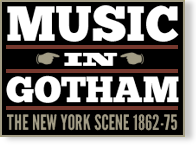St. Stephen Church Benefit
Event Information
Venue(s):
St. Stephen's Catholic Church
Price: $3
Performance Forces:
Instrumental, Vocal
Record Information
Status:
Published
Last Updated:
15 February 2013
Performance Date(s) and Time(s)
15 Apr 1866, EveningPerformers and/or Works Performed
Citations
“Grand Sacred Concert at St. Stephen’s Roman Catholic Church in Twenty-Eighth Street.—Another grand sacred concert, which will be participated in by a splendid array of talented artists, is announced to take place at St. Stephen’s Roman Catholic church on next Sunday evening. The object is one which will commend itself to the support of all Catholics resident in this city, it being the raising of more funds for the completion of the additions to St. Stephen’s church, commenced, it will be remembered, during the lifetime of the late Dr. Cummings…The artists who are to perform will be [lists performers]. Judging by the crowds that attended previous concerts at the church, there can be no doubt that the musical entertainment next Sunday evening will be a splendid success.”
“The concert in aid of the building fund of this church was largely attended on Sunday evening last. Dr. William Berge presided at the organ, and brought on the full powers of that magnificent instrument in a style which showed the accomplished artist. In one of his improvisations he introduced the March of the Prophet, and adorned that brilliant gem with Lisztian effects. Mr. Henry Appy’s violin added much to the effect of the concert. Of the vocal part of the programme the beautiful duet ‘Quis est homo,’ from Rossini’s Stabat Mater, Gonoud’s ‘Ave Maria,’ and ‘He shall feed his Flock’ were the only tolerable pieces sung. The former was admirably sung by Madame de Lussan and Miss Adelaide Philips, and the Ave Maria also well rendered by Madame de Lussan. The other artists made most miserable selections from Verdi, Donizetti and Meyerbeer. They picked out arias that the composers never intended to be sung outside the operas to which they belonged. It was like giving a few sentences or parts of sentences as representatives of the work of some great author. There is an unlimited repertoire of sacred music in the works of both German and Italian composers, without inflicting those mutilated opera pieces on an intelligent audience. Outside these, the concert was a complete success, and the Rev. Dr. McGlynn was materially aided in his laudable and enterprising work of completing this beautiful edifice.”
“The grand concert at St. Stephan’s Church, given in aid of the building fund for the payment for the enlargement of the church, was very largely attended, and as the price of the tickets was three dollars, a very handsome sum must have been realized. This church is admirably adapted to afford full and free production of tone both by voices and instruments, so that whenever artists who have been heard in the Academy—which is very unfavorable to vocal development—appear in St. Stephan’s, the difference of effect is really wonderful, their tone being absolutely doubled while they sing with perfect case, and free command of color and expression. This was fully evidenced in the performances of Miss Adelaide Phillips, Mazzoleni, Bellini and Antonucci. We have never heard these artists to such advantage. Miss Phillips sang ‘He shall feed His Flock’ with rare grace and expression, and two duets with Madam De Lussan and Signor Bellini, most effectively. Madam De Lussan, the soprano of the church, was in excellent voice, and sang the music allotted her in a manner worthy of warm praise.
Signor Bellini sang ‘E Morta’ by Donizetti, and in the Lombardi trio, most admirably in all respects. He is an artist of high merit, and always commands respect and admiration. Signor Antonucci surprised everyone accustomed to his singing in the Academy, with the rich, noble bass he poured out in lavish freedom that night, combined with a wealth of feeling and expression.
Signor Mazzoleni astonished the whole audience with his magnificent tenor voice, given out with a force which was electrical in its effect. It was entirely under his control, and he poured it out with wonderful volubility and power, giving to his performance varied color and deep expression, united to a perfection of phrasing and musical eloquence which we have rarely heard equaled. It was a performance which will not soon be forgotten.
Miss Stella Bonheur sang Verdi’s Romanza from ‘I Vespri Siciliani’ with abundant tone, general truth of intonation, and a fair degree of executive ability. She has, however, much to learn in method and style. Mr. Henri Appy and William Berge, acquitted themselves well in their respective positions and the concert was in every respect a marked success.”

